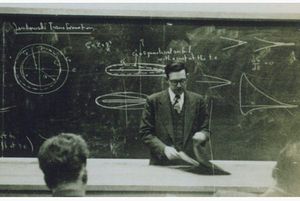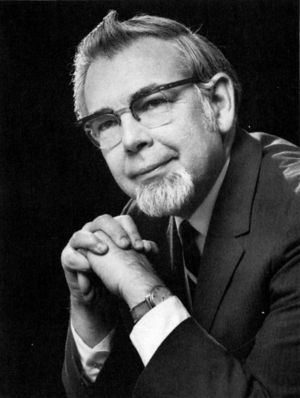Bernard (Ben) Etkin
| Bernard Etkin | |
|---|---|
|
In office Preceded by
Succeeded by
?th Chair of Engineering Science In office Succeeded by
?
| |
| Born |
May 7, 1918 Toronto, Ontario, Canada |
| Died |
June 26, 2014 (aged 96) Toronto, Ontario, Canada |
| Nationality | Canadian |
| Discipline | Engineering Physics |
| Fields | Aeronautics |
| Education | B.A.Sc. (1941); M.A.Sc. (1943); D.Eng. (Carleton 1971) |
| Alma mater | University of Toronto |
Bernard Etkin (1918-2014) was a Professor of Engineering at the University of Toronto Institute of Aerospace Studies. He was Chair of the Division of Engineering Science from 1967-1972, and Dean of Engineering from 1973-1979.
Biography[edit | edit source]
Family and Early Life[edit | edit source]
Bernard (Ben) Etkin was born in Toronto, Ontario, on May 7, 1918. Bernard Etkin was their only son and youngest of five children. His parents Samuel and Mary were poor Jewish immigrants from Belarus, and ran a small cleaning and tailoring business until it ran into trouble during the Depression. When the Etkins lost their family business, Ben, as he was known, quit high school to work at Philco assembling radios in order to support the family. He eventually completed high school through part time evening classes.[1][2]
Education[edit | edit source]
After graduating from high school, he enrolled as a part time student at the University of Toronto Faculty of Applied Science and Engineering, with his tuition paid for in part by his working sisters. He eventually enrolled full time and completed his degree in Engineering Physics in 1941. Following his graduation, Etkin joined the University of Toronto Department of Civil Engineering (which then housed the fledgling aeronautics researchers) as a graduate student and lecturer, finishing his Master's degree in 1943.[1][3]

Professor at UTIAS[edit | edit source]
When the Department of Aeronautics was created in 1946, Etkin was appointed as one of its first two faculty members (along with T.R. Loudon). He helped found the University of Toronto Institute of Aerophysics (later renamed University of Toronto Institute for Aerospace Studies, UTIAS) along with Gordon Patterson in 1949.[3]
As a member of UTIAS, Etkin continued to teach, but also conducted groundbreaking research into various areas of aeronautics. His research on aerodynamic theory led to 11 patents and three books on flight dynamics, including the seminal text Dynamics of Flight: Stability and Control.[4][5]
Etkin was involved in the design, production, and testing of 10 planes and two gliders during his time as a professor. His work included contributions to the Avro Arrow (for which he conducted research into wing aerodynamics) and the de Havilland "Sparrow" glider.[5]
Etkin also designed and built a large wind tunnel at UTIAS to test the effects of wind on buildings and aircraft. He consulted on the construction of Toronto City Hall in the 1960s.[1] He also invented the "infrasizer", an apparatus like a wind tunnel which sorted particles based on weight and resistance to airflow, of critical importance to aerospace studies.[5]
In addition to research, Etkin was known for his teaching. He taught over thirty different courses during his time as a professor, including both advanced aerospace courses and first year courses in mechanics.[5]
Apollo 13[edit | edit source]
On April 16, 1970, as the Apollo 13 NASA mission was in the midst of its troubled flight, Etkin and his colleagues received a call from Grumman Aerospace, the contractor responsible for the Lunar Modules on the Apollo landers. Grumman required the help of Etkin and five other engineers from UTIAS to solve the problem of how to safely separate the Lunar Module (LM) from the Command Module (CM) before re-entry.
During normal operation, the LM would have been separated from the CM prior to lunar landing using the Service Module's reaction control system (RCS). On Apollo 13, however, the RCS was inoperative because of the power failure caused by an earlier explosion in an oxygen tank in the Service Module. Re-entry into Earth's atmosphere with the LM attached was not an option, nor was a simple decoupling, since the LM was likely to tumble into the path of the CM as it entered the atmosphere.
Etkin's team, which included Barry French, Philip Sullivan, Peter Hughes, Irvine Glass, and Rod Tennyson, had only 6 hours to solve this problem, as the astronauts were running low on air and supplies in the last stages of its flight. Etkin's team concluded that pressurization of the airlocked tunnel between the LM and the CM would allow the LM to detach. However, the pressure had to be precisely calculated. If the pressure was too high, the tunnel hatch may be damaged; if too low, the LM would not safely separate.[1]
Using only slide rules, the team came up with a figure - two pounds per square inch - that would safely decouple the LM and the CM. This figure was relayed to Grumman, and was successfully used by NASA to save the Apollo 13 astronauts. Computer simulations conducted thirty years later verified the accuracy of the UTIAS numbers.[2]
The team was honoured for their work in a ceremony at the Canadian Air and Space Museum in 2010.[6]
Deanship[edit | edit source]

Etkin was appointed Dean of Engineering in 1973, replacing James Ham (who would later become President of the University of Toronto). As Dean, Etkin oversaw curriculum changes including the transformation of Geological Engineering into Geological Engineering and Applied Earth Science (later Mineral Engineering) and the establishment of a graduate program in Environmental Engineering.[3]
During his time as Dean, the engineering curriculum also transitioned from the year-long course system to a semestered system. Etkin was known as an advocate of professional experience and integration with the profession. His tenure also witnessed the introduction of an M.Eng. degree, as well as the establishment of the Professional Experience Year (PEY) program, which included in its pilot year job postings from de Havilland, with whom Etkin worked during his summers in the 1940s.[5]
Etkin served as Dean until 1979, when he was succeeded by Gordon Slemon.
Later Life[edit | edit source]
Bernard "Ben" Etkin died at the Baycrest Centre in Toronto on June 26, 2014, at the age of 96.[1]
Honours[edit | edit source]
Etkin's contributions earned him worldwide recognition in the field of aerospace. His awards and honours included:
- Honourary Doctor of Engineering from Carleton University (1971)[7]
- Founding Fellow of the Canadian Academy of Engineering
- Fellow of the Royal Society of Canada
- Fellow of the American Institute of Aeronautics and Astronautics (AIAA)
- Fellow of the Canadian Aeronautics and Space Institute
- Order of Canada (2003)[5]
- AIAA Aerospace Guidance, Navigation, and Control Award (2014)[8]
See Also[edit | edit source]
References[edit | edit source]
- ↑ 1.0 1.1 1.2 1.3 1.4 Judy Stoffman, "Bernard Etkin helped avert Apollo 13 tragedy", The Globe and Mail (23 July 2014).
- ↑ 2.0 2.1 George Haim, "Bernard Etkin, who mentored generations and helped rescue astronauts, dead at 96", The Toronto Star (4 August 2014).
- ↑ 3.0 3.1 3.2 Richard White, The Skule Story, (Toronto: University of Toronto Press, 2000).
- ↑ Bernard Etkin & Lloyd Duff Reid, Dynamics of Flight: Stability and Control, 3rd edition (Toronto: Wiley, 1995).
- ↑ 5.0 5.1 5.2 5.3 5.4 5.5 http://www.news.utoronto.ca/memoriam-university-professor-emeritus-bernard-ben-etkin
- ↑ http://www.thestar.com/news/gta/2010/04/13/u_of_t_engineers_recognized_for_apollo_13_rescue.html
- ↑ http://www3.carleton.ca/senate/honorarydegreesawarded.html
- ↑ http://www.engineering.utoronto.ca/About/Engineering_in_the_News/Bernard_Etkin_Honoured_by_the_American_Institute_of_Aeronautics_and_Astronautics.htm
